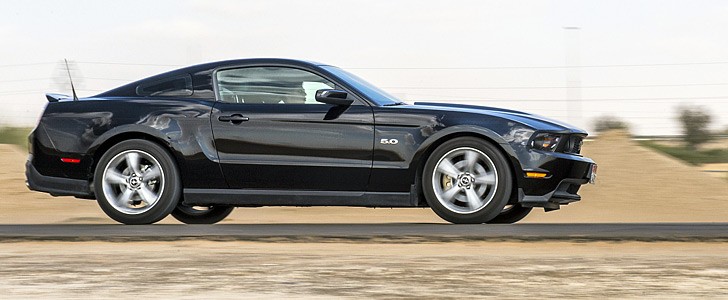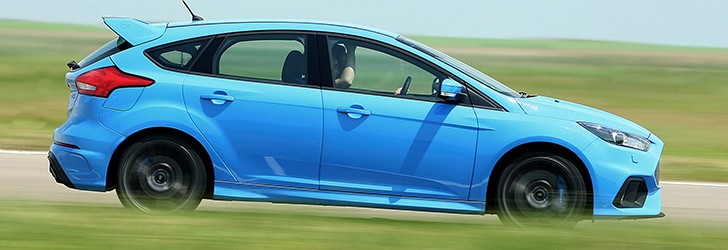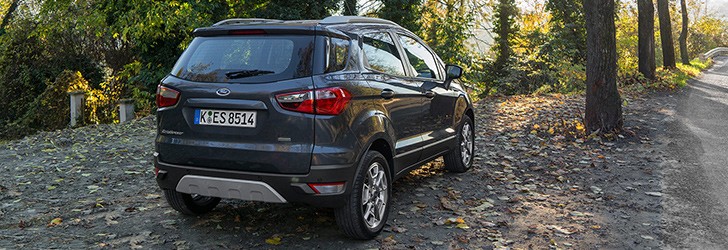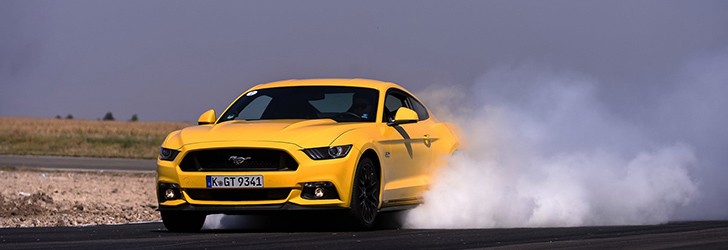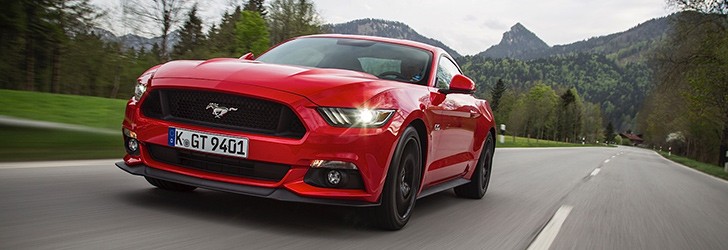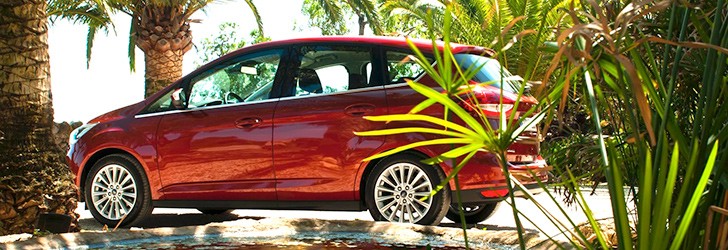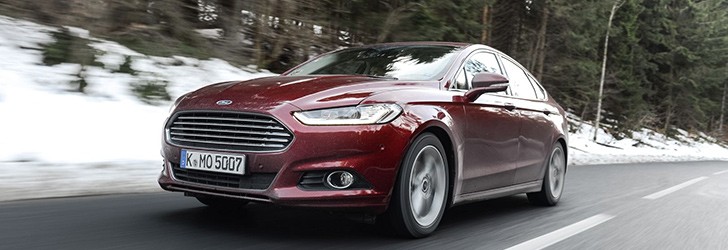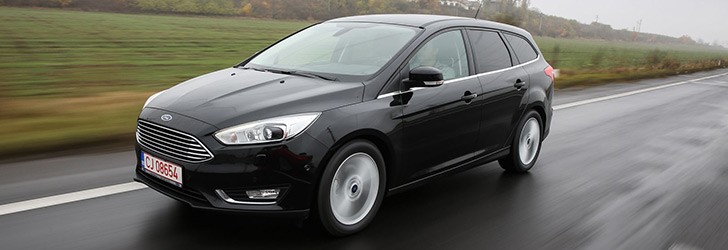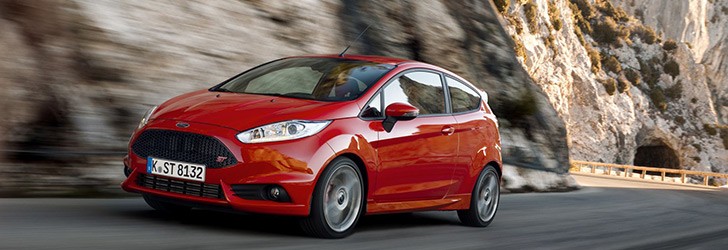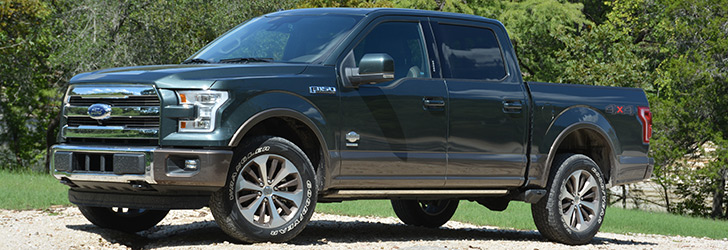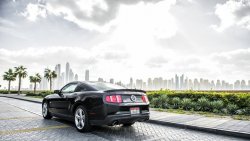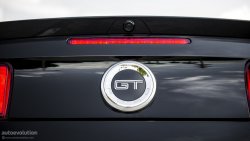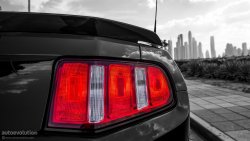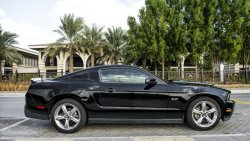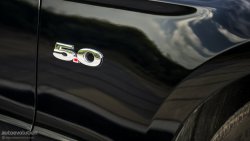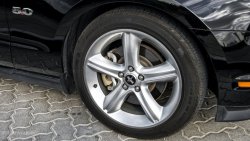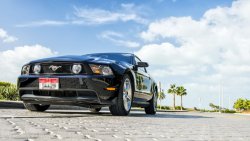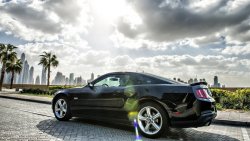FORD Mustang GT 5.0 Review
OUR TEST CAR: FORD Mustang GT 5.0 2012
We've already mentioned that the Mustang GT can be used to cover long distances with pleasure and one key factor for this is the level of comfort provided by the car.
One of the most important elements is the soundproofing and during our test we felt a perfectly balanced setup that kept most of the unwanted noises outside the cabin, but allowed the pleasant mechanical voices to enter.
Ford wanted to reduce the NVH level of the Mustang GT, so, besides the upgrades we already mentioned in the "Tech facts" chapter, the company also used additional sound proofing.
Extra sound-deadening material was used on the side of the instrument panel, while the doors and the rocker panels now use an extra seal for cutting wind noise. In addition to that, there's a new rear wheel arch liner, which limits the noise on wet and gravel roads.
Ford tells us that it has upgraded the suspension for handling, but the ride doesn't seem to have been sacrificed at all. No matter what type of road you drive on, the Mustang will keep you away from the road's dark side.
The next element that comes to support the car's comfort is the interior itself. This treats the front passengers with plenty of space and the seats keep one cozy even after hours and hours of driving. The seats in the back can't accommodate adults due to the limited head room, but children can use them regardless of the trip's length.
As for the materials used for the cabin, some of the plastics do look do cheap, but they're not unpleasant to touch. There are also parts of the interior, such as the metallic trimming on the dash or the steering wheel, which give you a pleasant touch sensation. You can also add the ergonomics to this story, as the controls are easy to use and within your reach.
Even the climate control system, which only offers one area and comes with manual control, was set up in a way that allows it to quickly adjust the temperature inside the vehicle without the passengers feeling assaulted.
When Ford upgraded the Mustang for the 2011 model year, the GT model got a heart surgery that took it into a new league. The vehicle dropped its 4.6-liter V8 that delivered 315 hp (319 PS) and 441 Nm (325 lb-ft). This was swapped with a new Coyote 5.0-liter unit producing 412 hp (418 PS) and 530 Nm (390 lb-ft) of torque.
The aluminum 4,951cc (302.13 cu.in.) powerplant uses cam-torque-actuated variable camshaft timing to increase power, efficiency, as well as engine response. The system relies on existing cam torque energy, as well as pressurized oil. It comes with a compact roller finger follower valvetrain setup, which allows for more generous ports that allow the unit to breath more freely. The breathing part is also supported by the ram air intake used by the engine.
The head bolt size was increased, while the head layout was modified in order to face higher cylinder head pressures and received a crossflow cooling scheme, all with the aim to face high-rpm use.
The lubrication system comes with increased capacity and while it is not a dry-sump one, it was designed to sustain the high lateral loads generated by track use. For example, it incorporates piston-cooling jets.
The engine is also 20 percent lighter compared to the previous 5.0-liter unit, as it uses aluminum for the block and heads. The unit also sheds weight thanks to the use of hollow camshafts, as well as composite cam covers and intake manifold.
Moving on to transmission department, we'll tell you that for the 2011 and 2012 six-speed manual GT models, you can choose between three rear axle ratios: 3.15, 3.55, and 3.73. It all depends on your preferences for fuel efficiency vs. short- or long-distance acceleration. As for the six-speed automatic we drove, this comes with a standard rear axle ratio of 3.15 and no options. We have to explain that the 6R80 six-speed automatic gearbox of our test car is built by Ford using a ZF design.
Ford tells us the Mustang not only gained extra muscle, but also superior efficiency. This comes thanks to the aforementioned Ti-VCT system and optimized six-speed automatic, as well to an extra rear decklid seal that improves aerodynamics. The EPAS (electronic power assisted steering), which offers three levels of assistance, also plays a role here.
In addition to increasing fuel efficiency, it also constantly monitors parameters like steering angle and yaw rate and compensates for unwanted movements generated by improper driving conditions. This means that, for example, it can counteract the effects of high lateral winds.
Since 2005, the Mustang is underpinned by Ford's D2C platform. The architecture, which is also known as S197, is currently only found on the sportscar. It borrows certain parts from the Ford DEW98 platform, which can be found under the Lincoln LS and Ford Thunderbird, among other vehicles.
However, the S197 is more orientated towards reducing costs, so while up front we have a MacPherson strut suspension setup, at the back the car we have a live rear axle setup. This features a three-link system with a Panhard rod for controlling the lateral movements of the axle. For the 2011 model we drove, the rear lower control arm was updated to increase stiffness, handling and reduce the NVH level.
The engineers also tweaked the stabilizer bars, as well as the spring and damper rates, aiming to improve handling. Form the 2011 model year onwards, not just the GT, but also the V6 model comes with a standard limited slip rear axle.
While the previous generation of the Mustang received independent rear suspension for the supercharged SVT Cobra model, the current one had been deprived of such technical assets.
In order to match the muscle of the engine with proper stopping power, Ford offers an optional Brembo braking package. This brings 14-inch ventilated discs for the front axle, as well as unique 19-inch alloy wheels and summer performance rubber.
The 2011 model year update saw the Mustang gain a number of extra standard features, with most of them aiming to increase the safety and comfort of the vehicle.
We'll start with the more serious upgrades, such as the Electronic Power Assist Steering (EPAS). Parents can now use the MyKey programmable vehicle key to limit the top speed or make sure the aforementioned ESC always stays on, while the integrated blind spot mirrors are an incredibly simple and effective feature. In addition to that, we have a standard message center, as well as a universal garage door opener.
The Mustang has also received a 2013 model year refresh, which has brought even more standard and optional equipment.
More importantly, the 2013 Mustang also gained new driving technologies. First and foremost, the engine was tweaked to deliver 420 hp, while the driver can now operate the six-speed automatic in a fully manual way. Called SelectShift, this doesn't override the driver's inputs, an important asset when you're doing some performance driving.
Those who want to introduce their Mustang to the track can go for the new optional GT Track Package, which is only offered for the manual GT models with a 3.73 rear axle. The kit includes upgraded brake pads, a larger radiator, an engine cooler, as well as the Torsen diff found on the Mustang Boss 302. It also includes the technical goodies found in the Brembo Brake Package.
For the 2013 model, Ford placed an important focus on lighting and gifted both the V6 and GT with standard high-intensity discharge (HID) headlamps. The car's mirrors now hold pony projection lights, which show the famous pony badge on the ground when the car is unlocked.
The instrument panel now holds a 4.2-inch LCD screen that can display fuel efficiency and performance information. One of the most interesting features shown on it is the Track Apps one, which shows data such as G forces or quarter mile times.
Other features worth mentioning are the Hill Start Assist for the manual models, as well as the optional leather- or cloth-finished Recaro seats. These come with head restraints that have been designed to accommodate occupants that wear a helmet.
And for those who put audio quality on top of their list of priorities, Ford offers two optional Shaker audio systems. The first uses eight speakers to deliver 370 watts, while the second comes with one extra speaker, releasing 550 watts of power into the cabin.
The Mustang Coupe was assessed by the IIHS (Insurance Institute for Highway Safety). It was subjected to a crash test that simulates a frontal offset crash with a vehicle about the same weight. The car received a "Good" rating, the highest one, for all areas.
The safety structure kept its shape well during the impact and the dummy movement was well controlled on both the forward and the rebound movements. The same rating was also given for protection offered to all areas of the body, including head & neck, chest, as well as both legs and feet.
But passive safety is just a part of the deal and Ford has made efforts to keep drivers from ending up using the two frontal and the two seat-mounted side airbags.
Among the upgrades bought by the 2010 model year, Ford made the AdvanceTrac Electronic Stability Control system a standard feature. In addition to that, for 2011, the Mustang received the MyKey programmable key. This means that while your dad may have just bought you a Mustang GT, he can limit your top speed to 80 mph (129 km/h), among others. Oh and he can also keep you from disabling the electronic stability and traction controls, so you can forget about burnouts and donuts.
If you are reading this as the father and you've bought the car for yourself, there's something we need to talk about. The GT's top speed is electronically limited to 155 mph (250 km/h). Even if you can get around the electronic nannies and remove the limiter with or without voiding the warranty, you shouldn't do this. That's because the car's mechanical bits and pieces were designed with this top speed in mind and they may not withstand the loads generated at higher speeds.
To give you an example, we'll remind you of a situation that we previously wrote about. We are talking about a video that shows a 2011 Mustang V6 owner destroying his car. The man had removed the 112 mph (180 km/h) top speed limiter and took the vehicle up to 135 mph (217 km/h). At that point, the singe-piece driveshaft of the car disintegrated, generating a mechanical storm under the car. Ford explained that the driveshaft used a light one-piece construction to balance performance and fuel efficiency and therefore this was not suitable for such high loads. In case you were wondering, the Mustang GT comes with a two-piece driveshaft, but we still don't advise you to try to trick its electronic speed limiter.
Ford had brought back the spirit of the original Mustang with the 2005 model year generation, but it is the 5.0 model we drove that truly manages to be a muscle car that you can use everyday.
The good part of the Mustang is the impressive package if offers. This car blends tradition, power and comfort and it's just as good for the daily commute and road trips as it is for smoking tires or playing at the drag strip.
The pony has also kept its affordability. You can walk into a Ford dealership right now and get a V6 Coupe starting from $22,200. As for the V8 version we drove, this comes with a starting price of $30,300. Of course, if you want a properly equipped one you'll be looking at a minimum price of $40,000. This might seem like a steep price for a Mustang, but if you consider the bouquet of assets it has to offer, you'll no longer see things this way.
The bad part of the Mustang is the live rear axle. This might be lighter and considerably cheaper than an independent rear suspension setup, but if seriously affects the handling and thus becomes the Achilles' Heel of the 'Mustang.
As for the ugly part, this title goes to the interior, but it's unfair to call the cabin this way. The design is pleasant and ergonomic, the fit and finish of the interior has evolved and there are only certain areas that would need better materials.
Ford is preparing to launch a new generation of the Mustang, which is expected to arrive in 2014 as a 2015 model. This will come with independent rear suspension and may get a downsized Ecoboost engine alongside the traditional V6 and V8 units. However, it will probably also swap the retro-inspired styling for a futuristic one.
There's no need to panic after reading the last part of the paragraph above. That's because we'll get at least one extra model year based on the current generation and this may bring interesting upgrades. If you follow the Mustang's recent evolution, you'll notice that Ford has constantly brought significant upgrades for its pony.
The 2010 model year came with a facelift that offered important visual changes. New V6 and V8 engines, as well as fresh transmissions, arrived for the 2011 model year. For the 2013 model year, the Mustang received more technology, both for the powertrain, as well as for the gadgets. We know that the 2013 Mustang can still be filed under "freshly squeezed", but we can't wait to see what the 2014 model year has to offer.
As for the European side of this story, while the Chevrolet Camaro is already being officially imported to the Old Continent, Mustang fans still have some waiting to do. Ford has confirmed that it will bring the Mustang to Europe, but the company hasn't offered any details so far. This might as well mean that the move will be made when the new generation is launched.
One of the most important elements is the soundproofing and during our test we felt a perfectly balanced setup that kept most of the unwanted noises outside the cabin, but allowed the pleasant mechanical voices to enter.
Ford wanted to reduce the NVH level of the Mustang GT, so, besides the upgrades we already mentioned in the "Tech facts" chapter, the company also used additional sound proofing.
Extra sound-deadening material was used on the side of the instrument panel, while the doors and the rocker panels now use an extra seal for cutting wind noise. In addition to that, there's a new rear wheel arch liner, which limits the noise on wet and gravel roads.
Ford tells us that it has upgraded the suspension for handling, but the ride doesn't seem to have been sacrificed at all. No matter what type of road you drive on, the Mustang will keep you away from the road's dark side.
The next element that comes to support the car's comfort is the interior itself. This treats the front passengers with plenty of space and the seats keep one cozy even after hours and hours of driving. The seats in the back can't accommodate adults due to the limited head room, but children can use them regardless of the trip's length.
As for the materials used for the cabin, some of the plastics do look do cheap, but they're not unpleasant to touch. There are also parts of the interior, such as the metallic trimming on the dash or the steering wheel, which give you a pleasant touch sensation. You can also add the ergonomics to this story, as the controls are easy to use and within your reach.
Even the climate control system, which only offers one area and comes with manual control, was set up in a way that allows it to quickly adjust the temperature inside the vehicle without the passengers feeling assaulted.
When Ford upgraded the Mustang for the 2011 model year, the GT model got a heart surgery that took it into a new league. The vehicle dropped its 4.6-liter V8 that delivered 315 hp (319 PS) and 441 Nm (325 lb-ft). This was swapped with a new Coyote 5.0-liter unit producing 412 hp (418 PS) and 530 Nm (390 lb-ft) of torque.
The aluminum 4,951cc (302.13 cu.in.) powerplant uses cam-torque-actuated variable camshaft timing to increase power, efficiency, as well as engine response. The system relies on existing cam torque energy, as well as pressurized oil. It comes with a compact roller finger follower valvetrain setup, which allows for more generous ports that allow the unit to breath more freely. The breathing part is also supported by the ram air intake used by the engine.
The head bolt size was increased, while the head layout was modified in order to face higher cylinder head pressures and received a crossflow cooling scheme, all with the aim to face high-rpm use.
The lubrication system comes with increased capacity and while it is not a dry-sump one, it was designed to sustain the high lateral loads generated by track use. For example, it incorporates piston-cooling jets.
The engine is also 20 percent lighter compared to the previous 5.0-liter unit, as it uses aluminum for the block and heads. The unit also sheds weight thanks to the use of hollow camshafts, as well as composite cam covers and intake manifold.
Moving on to transmission department, we'll tell you that for the 2011 and 2012 six-speed manual GT models, you can choose between three rear axle ratios: 3.15, 3.55, and 3.73. It all depends on your preferences for fuel efficiency vs. short- or long-distance acceleration. As for the six-speed automatic we drove, this comes with a standard rear axle ratio of 3.15 and no options. We have to explain that the 6R80 six-speed automatic gearbox of our test car is built by Ford using a ZF design.
Ford tells us the Mustang not only gained extra muscle, but also superior efficiency. This comes thanks to the aforementioned Ti-VCT system and optimized six-speed automatic, as well to an extra rear decklid seal that improves aerodynamics. The EPAS (electronic power assisted steering), which offers three levels of assistance, also plays a role here.
In addition to increasing fuel efficiency, it also constantly monitors parameters like steering angle and yaw rate and compensates for unwanted movements generated by improper driving conditions. This means that, for example, it can counteract the effects of high lateral winds.
Since 2005, the Mustang is underpinned by Ford's D2C platform. The architecture, which is also known as S197, is currently only found on the sportscar. It borrows certain parts from the Ford DEW98 platform, which can be found under the Lincoln LS and Ford Thunderbird, among other vehicles.
However, the S197 is more orientated towards reducing costs, so while up front we have a MacPherson strut suspension setup, at the back the car we have a live rear axle setup. This features a three-link system with a Panhard rod for controlling the lateral movements of the axle. For the 2011 model we drove, the rear lower control arm was updated to increase stiffness, handling and reduce the NVH level.
The engineers also tweaked the stabilizer bars, as well as the spring and damper rates, aiming to improve handling. Form the 2011 model year onwards, not just the GT, but also the V6 model comes with a standard limited slip rear axle.
While the previous generation of the Mustang received independent rear suspension for the supercharged SVT Cobra model, the current one had been deprived of such technical assets.
In order to match the muscle of the engine with proper stopping power, Ford offers an optional Brembo braking package. This brings 14-inch ventilated discs for the front axle, as well as unique 19-inch alloy wheels and summer performance rubber.
The 2011 model year update saw the Mustang gain a number of extra standard features, with most of them aiming to increase the safety and comfort of the vehicle.
We'll start with the more serious upgrades, such as the Electronic Power Assist Steering (EPAS). Parents can now use the MyKey programmable vehicle key to limit the top speed or make sure the aforementioned ESC always stays on, while the integrated blind spot mirrors are an incredibly simple and effective feature. In addition to that, we have a standard message center, as well as a universal garage door opener.
The Mustang has also received a 2013 model year refresh, which has brought even more standard and optional equipment.
More importantly, the 2013 Mustang also gained new driving technologies. First and foremost, the engine was tweaked to deliver 420 hp, while the driver can now operate the six-speed automatic in a fully manual way. Called SelectShift, this doesn't override the driver's inputs, an important asset when you're doing some performance driving.
Those who want to introduce their Mustang to the track can go for the new optional GT Track Package, which is only offered for the manual GT models with a 3.73 rear axle. The kit includes upgraded brake pads, a larger radiator, an engine cooler, as well as the Torsen diff found on the Mustang Boss 302. It also includes the technical goodies found in the Brembo Brake Package.
For the 2013 model, Ford placed an important focus on lighting and gifted both the V6 and GT with standard high-intensity discharge (HID) headlamps. The car's mirrors now hold pony projection lights, which show the famous pony badge on the ground when the car is unlocked.
The instrument panel now holds a 4.2-inch LCD screen that can display fuel efficiency and performance information. One of the most interesting features shown on it is the Track Apps one, which shows data such as G forces or quarter mile times.
Other features worth mentioning are the Hill Start Assist for the manual models, as well as the optional leather- or cloth-finished Recaro seats. These come with head restraints that have been designed to accommodate occupants that wear a helmet.
And for those who put audio quality on top of their list of priorities, Ford offers two optional Shaker audio systems. The first uses eight speakers to deliver 370 watts, while the second comes with one extra speaker, releasing 550 watts of power into the cabin.
The Mustang Coupe was assessed by the IIHS (Insurance Institute for Highway Safety). It was subjected to a crash test that simulates a frontal offset crash with a vehicle about the same weight. The car received a "Good" rating, the highest one, for all areas.
The safety structure kept its shape well during the impact and the dummy movement was well controlled on both the forward and the rebound movements. The same rating was also given for protection offered to all areas of the body, including head & neck, chest, as well as both legs and feet.
But passive safety is just a part of the deal and Ford has made efforts to keep drivers from ending up using the two frontal and the two seat-mounted side airbags.
Among the upgrades bought by the 2010 model year, Ford made the AdvanceTrac Electronic Stability Control system a standard feature. In addition to that, for 2011, the Mustang received the MyKey programmable key. This means that while your dad may have just bought you a Mustang GT, he can limit your top speed to 80 mph (129 km/h), among others. Oh and he can also keep you from disabling the electronic stability and traction controls, so you can forget about burnouts and donuts.
If you are reading this as the father and you've bought the car for yourself, there's something we need to talk about. The GT's top speed is electronically limited to 155 mph (250 km/h). Even if you can get around the electronic nannies and remove the limiter with or without voiding the warranty, you shouldn't do this. That's because the car's mechanical bits and pieces were designed with this top speed in mind and they may not withstand the loads generated at higher speeds.
To give you an example, we'll remind you of a situation that we previously wrote about. We are talking about a video that shows a 2011 Mustang V6 owner destroying his car. The man had removed the 112 mph (180 km/h) top speed limiter and took the vehicle up to 135 mph (217 km/h). At that point, the singe-piece driveshaft of the car disintegrated, generating a mechanical storm under the car. Ford explained that the driveshaft used a light one-piece construction to balance performance and fuel efficiency and therefore this was not suitable for such high loads. In case you were wondering, the Mustang GT comes with a two-piece driveshaft, but we still don't advise you to try to trick its electronic speed limiter.
Ford had brought back the spirit of the original Mustang with the 2005 model year generation, but it is the 5.0 model we drove that truly manages to be a muscle car that you can use everyday.
The good part of the Mustang is the impressive package if offers. This car blends tradition, power and comfort and it's just as good for the daily commute and road trips as it is for smoking tires or playing at the drag strip.
The pony has also kept its affordability. You can walk into a Ford dealership right now and get a V6 Coupe starting from $22,200. As for the V8 version we drove, this comes with a starting price of $30,300. Of course, if you want a properly equipped one you'll be looking at a minimum price of $40,000. This might seem like a steep price for a Mustang, but if you consider the bouquet of assets it has to offer, you'll no longer see things this way.
The bad part of the Mustang is the live rear axle. This might be lighter and considerably cheaper than an independent rear suspension setup, but if seriously affects the handling and thus becomes the Achilles' Heel of the 'Mustang.
As for the ugly part, this title goes to the interior, but it's unfair to call the cabin this way. The design is pleasant and ergonomic, the fit and finish of the interior has evolved and there are only certain areas that would need better materials.
Ford is preparing to launch a new generation of the Mustang, which is expected to arrive in 2014 as a 2015 model. This will come with independent rear suspension and may get a downsized Ecoboost engine alongside the traditional V6 and V8 units. However, it will probably also swap the retro-inspired styling for a futuristic one.
There's no need to panic after reading the last part of the paragraph above. That's because we'll get at least one extra model year based on the current generation and this may bring interesting upgrades. If you follow the Mustang's recent evolution, you'll notice that Ford has constantly brought significant upgrades for its pony.
The 2010 model year came with a facelift that offered important visual changes. New V6 and V8 engines, as well as fresh transmissions, arrived for the 2011 model year. For the 2013 model year, the Mustang received more technology, both for the powertrain, as well as for the gadgets. We know that the 2013 Mustang can still be filed under "freshly squeezed", but we can't wait to see what the 2014 model year has to offer.
As for the European side of this story, while the Chevrolet Camaro is already being officially imported to the Old Continent, Mustang fans still have some waiting to do. Ford has confirmed that it will bring the Mustang to Europe, but the company hasn't offered any details so far. This might as well mean that the move will be made when the new generation is launched.
THE END
12
Our FORD Testdrives:
Photo gallery (94)
